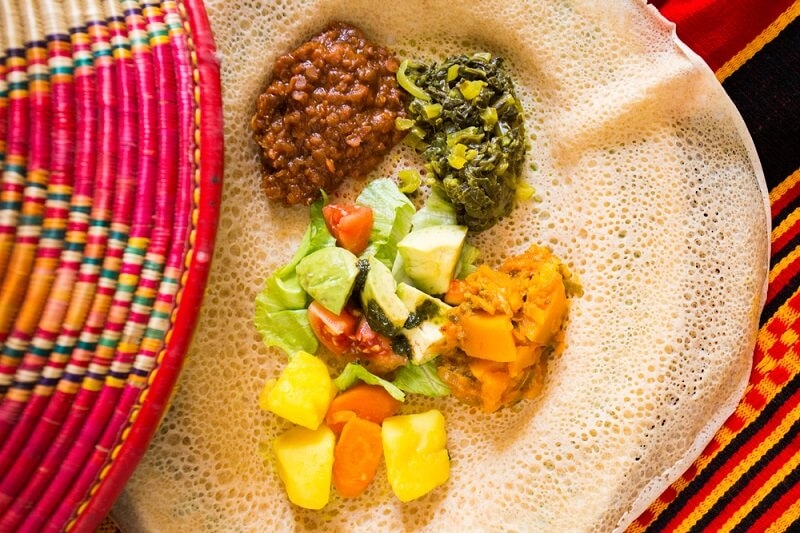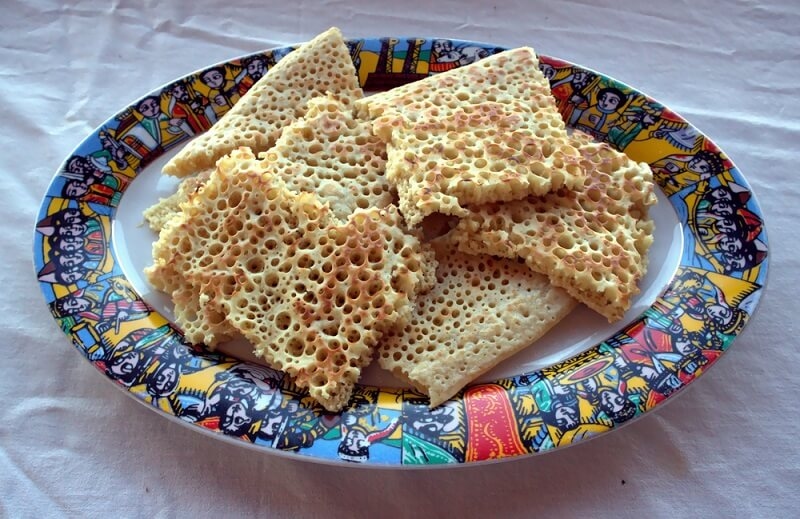
In East Africa, few foods take on the significance of injera, the spongy flatbread at the heart of Ethiopian cuisine. The Ethiopian Injera Recipe is more than just making food; it involves cultural practices that have traditions in nourishing food and community. Those people learning to make injera bread are often awed by the food's taste, texture, and flexibility. It is not only an authentic sourdough flatbread recipe but is also one of the distinct gluten-free African bread types that connect the dietary ways of modern people. It reveals an exemplary healthy African bread and is the key food for the many meals associated with the cooking guide for Ethiopian foods. Injera links our generations back, as it continues to reconnect with making and eating typical food, and connects religious ceremonies and everyday family meals.
Injera is not only bread but also a utensil, a plate, and a way to come together. Typically, there is a large round injera to serve the meal on, with many stews, vegetables, and proteins piled on top. Each diner can take pieces of injera to scoop up their desired food. The Ethiopian dining experience bridges the everyday act of eating a meal into a communal practice where everyone can enjoy a meal together.
The Ethiopian injera recipe is an essential symbol of togetherness, hospitality, and heritage. This bread cannot be separated from Ethiopian culture; it is the foundation of Ethiopian identity at the table.
The beauty of injera is that it is so straightforward. For a basic injera recipe, you need a few ingredients:
There are variations where teff is mixed with other flours like wheat, barley, or sorghum, but the best gluten-free African bread is made from 100% teff flour.

Making injera bread is an act of patience and understanding the fermentation process. Here is a simplified method:
Mix teff flour with water until it is smooth. Cover it and let it ferment for 2–3 days at room temperature. The fermentation process will create a naturally sourdough flatbread recipe.
It is ready once the batter smells slightly tangy and has bubbles on top. Stir it gently and add a pinch of salt.
Preheat a large flat skillet on high heat. Pour the batter spirally, spreading it thinly across the pan. Cover the pan with a lid and steam it for 1–2 minutes.
The traditional injera baking process will create small holes (called "eyes") across the surface of the bread. This shows that the batter has fermented and cooked correctly.
The injera can be used as a plate and a utensil. According to the Ethiopian food cooking guide, it is typically served with lentils, spicy chicken, or vegetables.
By following each step in this manner, you will be guaranteed to produce a tangy, spongy, and satisfying bread to pair with your dishes.
The sourdough flatbread nature of injera comes from the natural fermentation. Wild yeast and healthy bacteria in the air come together and ferment the teff flour by themselves, producing lactic acid. This lactic acid provides the tangy flavor of injera and makes it easier to digest, like the fiber and enzymes of the teff flour.
Unlike breads made with commercial yeast, injera is fermented slowly and develops flavor complexity, making it one of the truest, most nutritious African breads available today.
No Ethiopian food cooking guide is complete without highlighting the stews and sides that pair with injera:
Injera complements each dish by balancing heat and richness, turning a simple meal into a balanced feast.
For those seeking alternatives to wheat-based bread, injera is a gift. Made with teff, a tiny ancient grain, it is naturally gluten-free and nutrient-rich, making it a standout option among gluten-free African bread choices.
Teff flour provides:
No wonder many enjoy injera as part of a global trend toward healthy African bread.
Injera is not simply about delicious taste—it is a nutritional powerhouse. The Ethiopian injera recipe made with teff has the potential to contribute to:
Ethiopia is the home of injera, but similar bread exists across Africa:
These variations are the creative use of grains and fermentation that Africans produce to offer different versions of the sourdough flatbread recipe tradition.
Even experienced cooks may struggle with injera at first. Here are some tips:
These strategies will help anyone master how to make authentic injera bread.
In addition to being a bread, injera helps to portray a fuller Ethiopian food cooking guide about balance. A typical meal includes:
This structure illustrates how injera can help provide a healthy diet while delivering a remarkable taste experience.
Teff is one of the oldest grains on the planet, and Ethiopia has been using it as a source of nourishment for thousands of years! The injera recipe is one of the oldest, timeless recipes because it has practicality, taste, and health in its design. It is connected to the earth and people in a way that processed bread cannot; therefore, injera is a truly African bread.
Today, injera is enjoyed globally and is often served in African restaurants abroad. It has become a symbol of Ethiopia’s culinary heritage and a point of cultural pride. Its popularity also grows because of rising interest in gluten-free African bread and plant-based lifestyles.
The Ethiopian Injera Recipe you have found is more than a recipe—it is a traditional, healthy, and flavorful recipe. Suppose you are learning to make injera bread, trying out a sourdough flatbread recipe, or seeking a naturally gluten-free African bread. In that case, injera is an indicator of culture and good health. It should be a primary component of any Ethiopian food cooking guide, and it is also one of the oldest and healthiest African breads today.
This content was created by AI